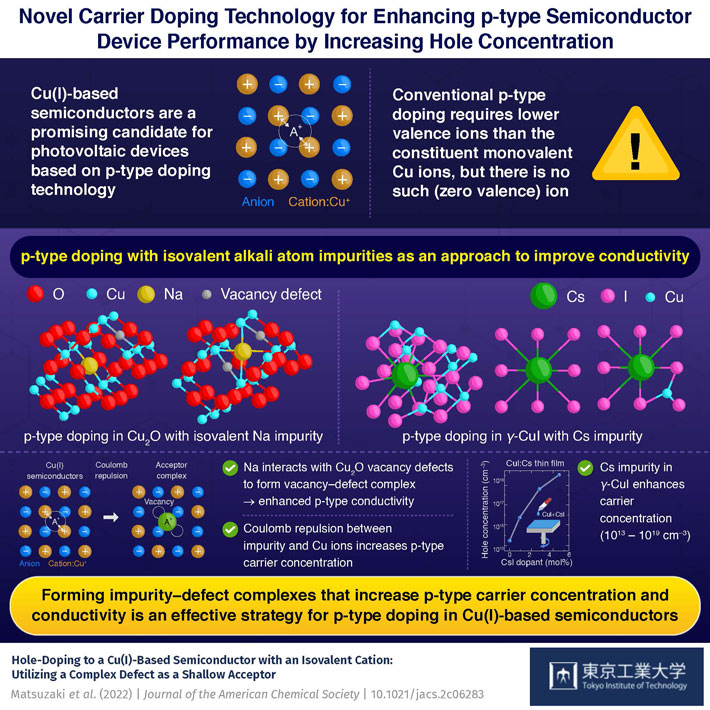The carrier concentration and conductivity in p-type monovalent copper semiconductors can be significantly enhanced by adding alkali metal impurities, as shown recently by Tokyo Tech researchers. Doping with isovalent and larger-sized alkali metal ions effectively increased the free charge carrier concentration and the mechanism was unraveled by their theoretical calculations. Their carrier doping technology enables high carrier concentration and high mobility p-type thin films to be prepared from the solution process, with photovoltaic device applications.

Perovskite solar cells have been the subject of much research as the next generation of photovoltaic devices. However, many challenges remain to be overcome for the practical application. One of them concerns the hole transport layer (p-type semiconductor) in photovoltaic cells that carries holes generated by light to the electrode. In conventional p-type organic transport semiconductors, hole dopants are chemically reactive and degrade the photovoltaic device. Inorganic p-type semiconductors, which are chemically stable, are promising alternatives, but fabrication of conventional inorganic p-type semiconductors requires high temperature treatment. In this regard, the p-type inorganic semiconductors that can be fabricated at low temperatures and have excellent hole transport ability have been desired.
Inorganic p-type copper iodide (CuI) semiconductor is a leading candidate for such hole transport materials in photovoltaic device applications. In this material, native defects give rise to charge imbalance and free charge carriers. However, the overall number of defects is generally too low for satisfactory device performance.
Adding impurities with acceptor (positively charged) or donor (negatively charged) properties, known as "impurity doping," is the gold standard method for bolstering the transport properties of semiconductors and the device performance. In conventional methods, ions with lower valency than the constituent atoms have been used as such impurities. However, in Cu(I)-based semiconductors, there is no ion with a valence lower than that of monovalent copper ions (zero valence), and thus a p-type doping in copper compounds has not been established.
To propose a new carrier doping design for p-type doping in CuI, researchers from Japan and USA recently focused on the alkali impurity effect, which has been empirically used for hole doping in copper monovalent semiconductors, copper oxide (Cu2O) and Cu(In,Ga)Se2.
In a novel approach outlined in a study published in the Journal of the American Chemical Society, the team, led by Dr. Kosuke Matsuzaki from Tokyo Institute of Technology (Tokyo Tech), Japan, demonstrated experimentally that p-type doping with alkali ion impurities, which has the same valence as copper but larger size, can improve conductivity in Cu(I)-based semiconductors. The theoretical analyses show that the complex defects, which are composed of alkali ion impurity and vacancies of copper ions, are an origion of hole generation (p-type conductivity).
While alkali metal impurities are known to increase the carrier concentration in copper oxide, the underlying mechanism remained a mystery to scientists, until now. This mechanism has now been elucidated, as Dr. Matsuzaki explains, "Using a combination of experimental studies and theoretical analysis, we managed to uncover the effect of the alkali impurities in Cu(I)-based semiconductors. The alkali metal Na impurity interacts with neighboring Cu ions in Cu2O to form defect complexes. The complexes, in turn, lead to be a source of holes."
As an impurity is added to the crystal structure, electrostatic Coulomb repulsion between the impurity and neighboring Cu ions pushes the Cu atoms from their positions in the structure and leads to the formation of multiple acceptor-type copper vacancies. This, in turn, increases the total p-type carrier concentration and, consequently, p-type conductivity. "Our simulations show that it is critical that the impurity is somewhat larger for vacant spaces in the crystal lattice to invoke electrostatic repulsion. For alkali impurities smaller, for example lithium, the impurity ions fall into the interstitial sites and do not sufficiently deform the crystal lattice," elaborates Dr. Matsuzaki.
Based on the p-type doping mechanism to form acceptor-type Cu vacancy defect complex, the team investigated larger alkaline ions, such as potassium, rubidium, and cesium (Cs), as acceptor impurities in γ-CuI. Among them, the Cs ions could bind even more Cu vacancies, leading to even greater concentration of stable charge carriers (1013 – 1019 cm-3) both in single crystals and thin-films prepared from the solution. "This suggests that the method can be used to fine-tune carrier concentrations under low-temperature processing for specific applications and devices. This would allow a whole new range of applications for these p-type materials," concludes Matsuzaki.
Indeed, the development could be a major leap forward for copper(I)-based semiconductors, and could soon lead to their practical applications in solar cells and optoelectronic devices.
Reference
Authors : |
Kosuke Matsuzaki1,*, Naoki Tsunoda2, Yu Kumagai2, Yalun Tang3, Kenji Nomura3,4, Fumiyasu Oba1,2, and Hideo Hosono1,5
|
Title of original paper : |
Hole-Doping to a Cu(I)-Based Semiconductor with an Isovalent Cation: Utilizing a Complex Defect as a Shallow Acceptor |
Journal : |
Journal of the American Chemical Society |
DOI : |
|
Affiliations : |
1 Materials Research Center for Element Strategy, Tokyo Institute of Technology 2 Laboratory for Materials and Structures, Institute of Innovative Research, Tokyo Institute of Technology 3 Department of Electrical and Computer Engineering, Jacobs School of Engineering, University of California San Diego 4 Materials Science and Engineering Program, Jacobs School of Engineering, University of California San Diego 5 National Institute for Materials Science (NIMS) |






